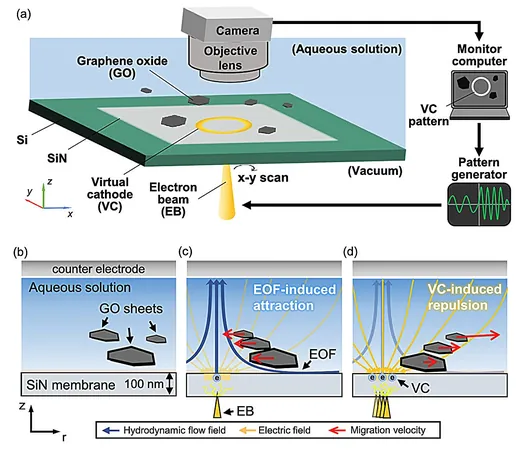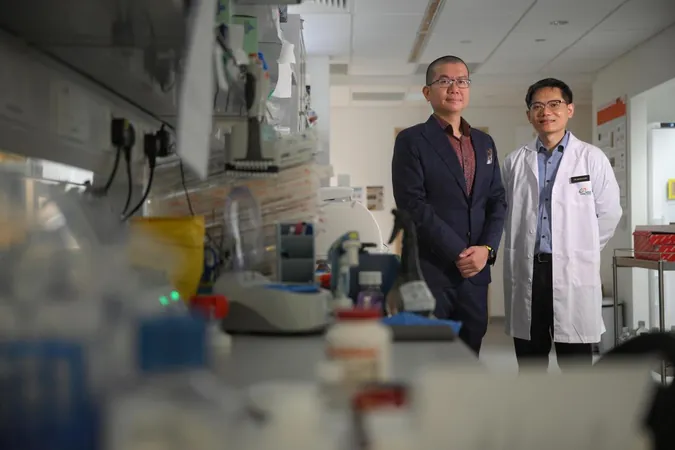
Revolutionary Breakthrough: Scientists Unleash 'Virtual Sorting Nanomachines' with Electron Beams!
2025-05-22
Author: Rajesh
A New Era in Nanotechnology
Researchers at Nagoya University in Japan have made an extraordinary leap in nanotechnology by inventing a groundbreaking interface that generates "virtual sorting nanomachines," eliminating the need for cumbersome physical devices.
Harnessing Electron Beams for Precision
Using targeted electron beams on ultra-thin silicon nitride membranes, these scientists have developed programmable electric fields that operate similarly to microfluidic devices, which are systems designed to move minute amounts of fluids through tiny channels. This ingenious method allows for the precise movement and sorting of nanomaterials based on their size, right where and when it’s needed.
The Magic of Graphene Oxide
At the heart of this revolutionary technique is graphene oxide (GO), a remarkable one-atom-thick carbon material. Its behavior and interactions with cells can vary dramatically depending on its size, making size-based sorting crucial. Traditional separation methods typically rely on fixed, complex microfluidic devices. However, this innovative approach overcomes those limitations with temporary, programmable electric fields that can be quickly altered.
Dynamic Forces at Play
When these electric fields are applied to a GO solution, two opposing forces come into play: an electroosmotic flow that draws the sheets toward the electric pattern and an electrophoretic repulsion that pushes them away. The movement is influenced by the differing surface charge-to-mass ratios among GO sheets of various sizes.
Interestingly, smaller GO sheets possess less overall charge but also weigh less, giving them a higher charge-to-mass ratio. This unique characteristic allows them to be repelled more forcefully, enabling faster movement. The researchers found that as the size of the sheets decreases, their speed of evasion increases, effectively allowing for size-based separation.
Tailored Electric Patterns for Enhanced Control
By manipulating the electric field patterns, the researchers have vastly improved the sorting abilities of the graphene sheets. They devised intricate ring patterns that can be adjusted in real-time, enhancing the separation efficiency of various-sized sheets, and even created dynamic semi-circular patterns to direct movement within the solution.
A Paradigm Shift in Nanomaterial Processing
Ken Sasaki, a Ph.D. student and lead author of the study, stated, "This research represents a paradigm shift in nanomaterial processing. Instead of relying on complex devices, we can now program virtual nanomachines that emerge as needed, allowing for material-free manufacturing where tasks are executed by programmable force fields."
Promising Applications for Sustainability and Health
Professor Takayuki Hoshino from the Department of Micro-Nano Mechanical Science and Engineering highlighted the immense potential of this technology for both environmental and healthcare applications. "For instance, in the event of an industrial spill, we could deploy this technology on-site to quickly sort GO sheets, optimizing the removal of contaminants without the need for transportation to a facility," he explained.
The Future Looks Bright
This innovative research not only sets the stage for advanced nanotechnology but also opens the door to practical solutions for pressing environmental challenges. With virtual sorting nanomachines leading the way, the future of nanomaterials seems more sustainable and efficient than ever!



 Brasil (PT)
Brasil (PT)
 Canada (EN)
Canada (EN)
 Chile (ES)
Chile (ES)
 Česko (CS)
Česko (CS)
 대한민국 (KO)
대한민국 (KO)
 España (ES)
España (ES)
 France (FR)
France (FR)
 Hong Kong (EN)
Hong Kong (EN)
 Italia (IT)
Italia (IT)
 日本 (JA)
日本 (JA)
 Magyarország (HU)
Magyarország (HU)
 Norge (NO)
Norge (NO)
 Polska (PL)
Polska (PL)
 Schweiz (DE)
Schweiz (DE)
 Singapore (EN)
Singapore (EN)
 Sverige (SV)
Sverige (SV)
 Suomi (FI)
Suomi (FI)
 Türkiye (TR)
Türkiye (TR)
 الإمارات العربية المتحدة (AR)
الإمارات العربية المتحدة (AR)